|
|
|
| This document is available in: English Castellano Deutsch Francais Italiano Nederlands Russian Turkce |
![[Photo of the Author]](../../common/images/Georges-Tarbouriech.jpg)
by Georges Tarbouriech About the author:
Georges is a long time Unix user (commercial and free). As an old NeXT lover, he is
very fond of free projects using the look and feel of this great OS.
Content: |

Abstract:
More than 10 years ago, an incredible machine with an even more incredible OS was released. It was called NeXT and NeXTStep was the name of the OS. We had never seen something like that before : it was a very nicely designed machine, with a breathtaking display. The OS was based on BSD 4.2 at the beginning and 4.3 a bit later, with a very compact mach kernel. With it, appeared the first graphical and object oriented development tool : Interface Builder (Thanks to Jean-Marie Hullot and Bertrand Serlet for such an unbelievable tool). Commercially speaking, this machine didn't really succeed. Then, NeXT decided to port the framework to different OSes such as Sun, for instance. This API was called OpenStep. From there, GNU started a big project, GNUstep, http://www.gnustep.org, to build a free OpenStep implementation. This article tries to present this great work, even if it is not yet finished.
For GNUstep, you need another great free product : Window Maker. It's a window
manager a la NeXT. If you don't know it yet, you can take a look at it. At the time of this writing,
the latest version is 0.64.0.
This window manager is part of the GNUstep project and you can get it from
http://www.windowmaker.org.
Let's add, Window Maker runs on almost every Unix platform, either commercial or
free. It's a bit different as far as GNUstep is concerned. It will run on most
Linux flavors, NetBSD, FreeBSD, OpenBSD, it is more or less stable dependent on
the OS you run it on. Regarding commercial Unixes, it will run on Solaris, Irix...
with more or less stability.
Once your screen looks like NeXTStep, you can go to GNUstep web-site to get
everything you need.
And what do you need ? Obviously, an objective C compiler (remember, it's an
object oriented framework). gcc 2.8 and up will do the trick. Recommended is the
libobjc. Apart from the tools needed to compile, you need GNUstep
stuff : that is the base library, at least, the gui library, the X11 backend (xgps or
xdps)... and so on.
There is a lot you can download, it's up to you : check the list to make your
choice. For instance, you can get Gorm which is the Interface Builder
implementation (only as CVS), and of course, the examples or the users apps.
You just have to compile what you downloaded ! Seriously, you should read the
READMEs, the INSTALLs. You also have a GNUstep HOWTO, recommended reading.
After compiling, most of your work will concern environment variables and
programs to launch at startup time (the engine for instance, called gdnc).
As mentioned earlier, you can have two different backends : the X one and the
dps one which is the Display PostScript free implementation. This last will
provide much better results but it's much less evolved than the X backend.
According to your OS, check the paths, when defining the environment variables.
At least, you must define the GNUSTEP_SYSTEM_ROOT variable and the path to the
different scripts or programs.
Once you have finished with this part, you can "play" with GNUstep.
There are a lot of examples available from the GNUstep website, either going to the User
apps section or to the download section. They are the best way to get familiar
with GNUstep if you don't know NeXTStep or OpenStep. Most of them are working
examples and allow to understand the philosophy behind the framework. Looking at
the code will teach you a lot about Objective C. For someone knowing C, Objective
C is quite easy to learn, and in any case much easier than C++ (well, this is
only my opinion).
Among these examples, a very nice one is the font panel. It really looks like
the original one. By the way, along this article we'll show screen shots both from
GNUstep and NeXTStep, thus you'll be able to compare. Here is the first example
: the font panel from the GNUstep and the one from NeXTStep.
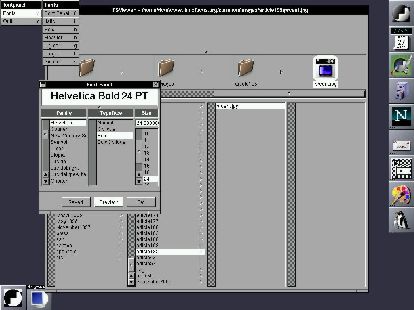
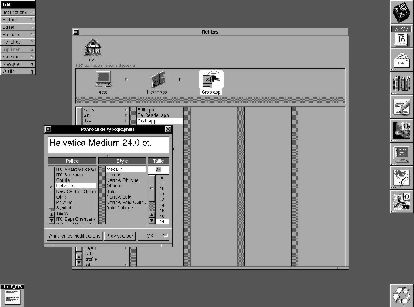
Another interesting example is the Edit app. It isn't fully working but it's a
nice work rather close to the original.
One of the most teaching example is called GSTest. Running GSTest allows you to
understand everything about windows, buttons, scroll bars... It's an all in one
work ! A look at the source code is better than a book.
Of course, it doesn't mean the other examples have no interest : they do have !
Simply, the author of many apps, Nicola Pero, has done a very great job.
Another great app from the same Nicola, is called Finger. It's a gui for finger
(would you have guessed?), ping, traceroute. Here it is :

We could mention many more apps but let's leave the pleasure of discovery to the
reader.
A major revolution brought to us by NeXTStep was Interface Builder. As
its name says, it was a tool to create a gui for your application. But, what a
tool ! Remember, that was at the end of the 80's : just incredible !
Why was it a revolution : because you were able to build a window with all its
stuff in less than 5 minutes ! That is, a window with its menu, its buttons, its
sliders, etc, was created by dragging objects from a palette to this window.
Then it was possible to link these objects to other windows or menus or
whatever. A minimal code was generated and you just had to complete it.
Obviously, these objects, once created could be reused somewhere else.
Unbelievable at that time !
Since then, many big software editors tried to do the same : in my humble
opinion, they never reached the level of the original.
And now, you can have such a tool for free ! It's called Gorm (GNUstep Graphics
Object Relationship Modeler) and the author is Richard Frith-Macdonald.
Gorm is only available as CVS from the GNUstep website. Version is only 0.1 at the
time of this writing, nevertheless it works even if a lot of functions are
missing. To discover Interface Builder look and feel, Gorm is the right tool.
Here is a very simple (and stupid) example, once again with the equivalent from NeXTStep.
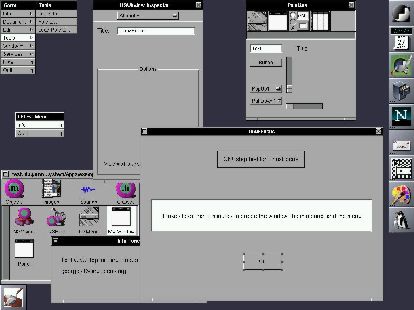
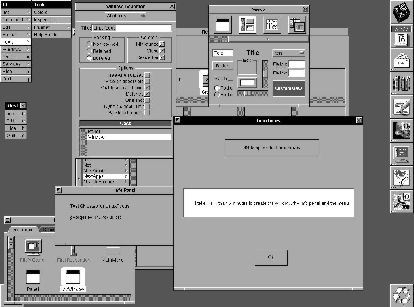
As we said before, this tool and its model Interface Builder are used to create
the graphical part of an application. Of course, it isn't enough to make this
application work. You'll have to complete the generated code and manage the
different sources as for any application project. Last, you'll have to compile
your work.
Here comes the second big tool, called Project Builder under NeXTStep and
ProjectCenter under GNUstep. ProjectCenter is the work of Philippe C.D Robert
and version number is 0.2. Once again, this tool is a working one despite the
version number. You can manage your project as you would with Project Builder
under NeXTStep. Obviously, there's a lot of work to be done but this one too, is
worth downloading.
Here is how it looks like compared to its "father".
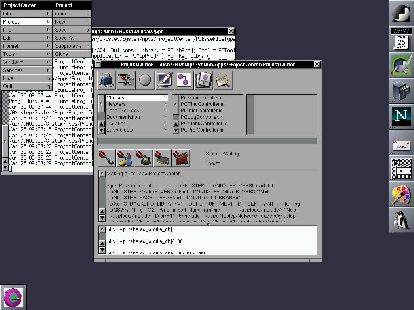
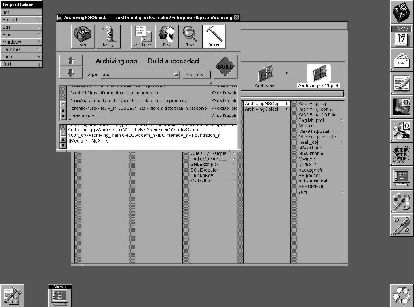
Using those two tools is rather simple if you know NeXTStep or OpenStep. If you
never used them before, you'll have to find the philosophy behind them. A lot of
documentation is available and it is recommended reading (not to say compulsory
reading). But once you understood how it works... you can't live without !
You've been warned.
We must mention other great things such as GWorkspace or GSBench. The GNU 3DKit is
another wonderful piece of software. It's an API designed to work on top of OpenGL. You'll find it
at http://www.nice.ch/~phip/softcorner.html
with many other applications.
The tools we'll mention here are designed to port apps from OpenStep to GNUstep.
But, as a matter of fact, they go much further since they will allow you to port
Mac OS X apps as well. That's the important point : more on this later !
First, there's a tool called OpenStep2GNUConverter, allowing you to convert a
PBProject (Project Builder) to a GNUstep Makefile. That is, you'll be able to
compile an OpenStep project on your Linux box (for instance) .
To compile this project, you'll need another tool called nfmake.
A tool called nib2gmodel allows to convert a nib file
(produced with Interface Builder) to its equivalent under GNUstep, named gmodel.
Last but not least, you can get gstep-db, a database library and even
more, an Oracle adaptor.
NeXTStep and OpenStep used to provide you with adaptors for Sybase and
Oracle, that is an interface to query databases from these editors. GNUstep
offers you the same for free (under NeXTStep or OpenStep, you needed the
developer kit which was quite expensive, but you had the Enterprise Object
Foundation for free - a lot of examples).
Of course, these tools can be downloaded from the GNUstep website.
Unfortunately I was unable to test all this stuff, since I "only" got an old
NeXT station and I'm (impatiently) waiting to get Mac OS X at work. But I've been trusting GNU
for about 15 years and I won't change today ! I feel like saying : all this
should work for sure. Anyway, within a few months I will test all this...
If you are interested in developing under this great framework, there's a lot of
documentation you can get, as already mentioned. The ease of use is not a legend,
but you need some knowledge about the way it works.
From the GNUstep website, you can find many useful links. However, some of them
deserve special attention.
Going to http://www.gnustep.org/resources/documentation.html
will provide you with the general GNUstep documentation. You'll find there an
Objective C book, installation instructions, FAQ...
There's also a documentation about the GNUstep library.
And even more, you'll find
tutorials. Nicola's one is recommended reading. You can then visit http://www.gnustep.it/nicola/Tutorials
Another place to visit is the resources section : there are tons of links to
articles, development sites...
The http://www.gnustep.net/ website is as well of interest.
That is, you can find everything you need to start with GNUstep.
The strange story of NeXT carries on, let's hope with success that time, under
the name of Mac OS X. What a great thing ! What do you think about an OS born
more than 10 years ago starting a new career ? It was quite ahead, don't you
think ?
But what does that mean for us ? Well, probably a lot of great apps since all
the existing ones can be easily recompiled, and don't forget, Mac OS X and so
NeXTStep are Unix systems. That means tons of applications potentially
available, as well for free Unixes. Accordingly, GNUstep is the framework you need...
Let's say it's a dream (sort of) : at least, we would be able to choose the
software we want. Unfortunately, there is a bright side and
a dark side.
Let's take an example : today, according to the OS you use, you don't have much
choice concerning web browsers. It's either Netscrape (and its derivatives) or
Exploder, that is two gas factories and a match box, security holes, and so
on. Mac OS X will provide you with OmniWeb : this is a really great web browser.
Using it under NeXTStep is a pleasure, even if it's a rather old version.
It's that sort of browser you can dream of today, when you use Unix or M$ things. The
only "thin" web browsers today can be found under so called alternative OSes :
such as NetPositive under BeOS or AWeb, for instance, under AmigaOS. Of
course, Opera seems attractive, but till now, I'm not quite convinced (but this
is only my opinion). What I mean here, is Mac OS X and so GNUstep will provide
us with "new" tools, often better than the ones we can use today. We did benefit
from such tools about ten years ago... with NeXTStep !
Of course, this is true for many other types of software and not only for
web browsers.
Going to http://www.omnigroup.com/ will show you a
bunch of available tools.
The main difference between GNUstep and Mac OS X comes from the fact that
X-Window is used for GNUstep but not under Mac OS X.
That was already a complaint about
NeXTStep. That's where GNUstep becomes so important : it allows you to use these
apps under X. This is probably one of the main strong points of this project : those
people really did a great job.
We can fear the arrival of Exploder and some others
pieces of s...oftware from the same editor under Mac OS X. This is a bit
frightening ! If these "apps" are Mac OS X native ones, we can expect the worst.
That is, the insidious entry of the Redmond army into the free Unix world. Of
course, here free doesn't mean gratis since we are talking about M$ thieves,
but... If you want to know the applications under development for Mac OS X, just have
a look at http://www.apple.com/macosx/applications/
Let's say, it's the pessimistic way of thinking : wait and see !
However, lets not forget that GNUstep is particularly designed for development. Once it
will become a bit more achieved, you'll be able to develop applications the
easy way, like it was under NeXTStep. GNUstep is much more than a single
framework, we could say it's a big IDE (Integrated Development Environment). The
most important point seems that these apps will be easily portable, to Mac OS X, for
instance.
By the way, let's not forget the Apple's open source, Darwin. More on the subject
at http://www.opensource.apple.com//
Obviously, there's much more to say about GNUstep but it's beyond the scope of
this article. The goal was to make you feel like trying this great product, and
why not, participating in this big project.
One of my greatest pleasure concerning free software comes from these projects
trying to "repair" the big commercial mistakes. NeXTStep was for me a true
revolution. I'm the very happy owner of a 10 years old workstation, and don't
believe it's covered with dust : I use it almost everyday despite its 68040/25
Mhz CPU. Fortunately (or unfortunately), many people seem to think the same.
Thanks to the GNUstep team, to the Window Maker team to provide us with such a
great work.
The incredible thing about NeXTStep comes from the fact that many
editors tried to "clone" it... and they did succeed where the model failed.
Once again, we must mention the Redmond Kingdom : have you ever noticed the
W95 windows and their gadgets ? Well, have a look at the NeXTStep screen shots
above. NeXTStep first appeared in 1987 in USA and around 1990 in Europe. As its name
says, the thing from M$ appeared more than five years later. The leaflets flying
between two folders, invented in the surrounds of Seattle, were present under
NeXTStep 2.1, that is around 1991...
Nevertheless, for once, they didn't copy in Redmond ! No, they did much better :
they "bought" people from NeXT... I suppose for many, many bucks. Never mind,
but that's not fair, is it ?
This to say NeXTStep never left people indifferent, what is an understatement.
GNU is the absolute reference concerning free software and it deserves to be.
The whole world owes GNU a lot : every OS has been able to benefit from their
work. Their compilers are probably the best ones ever seen, whatever the OS.
That's true for many other tools. Even more, their projects are often (if not
always) as great as their tools. GNUstep is one of them. By the way, NeXTStep
had a GNU directory...
If you are like me, not very fond of the well known (free or commercial) Unix
desktop environments, try
GNUstep, you'll love it ! Even more, you won't be able to work without.
Enjoy !
What a great time we're living in!
|
|
Webpages maintained by the LinuxFocus Editor team
© Georges Tarbouriech, FDL LinuxFocus.org Click here to report a fault or send a comment to LinuxFocus |
2001-04-27, generated by lfparser version 2.13